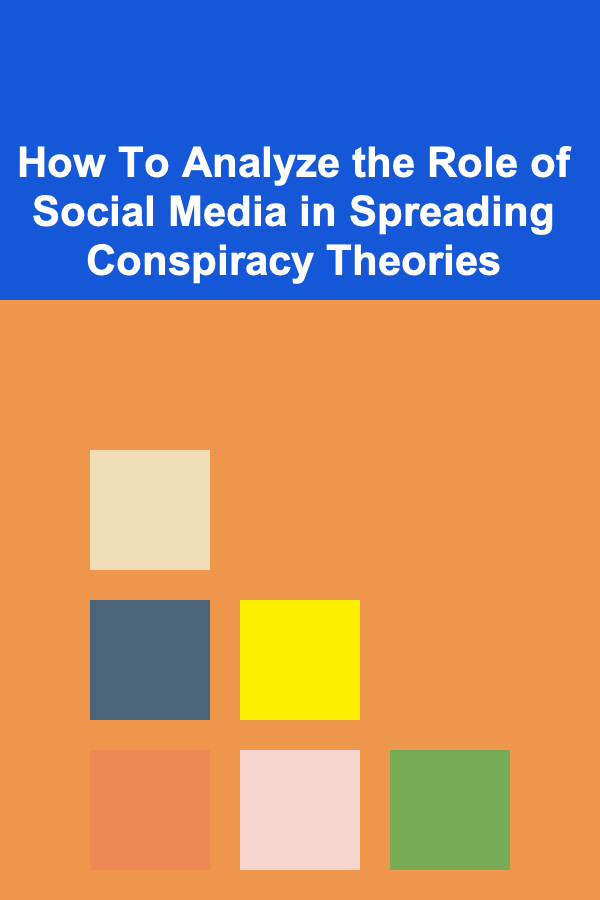
How To Analyze the Role of Social Media in Spreading Conspiracy Theories
ebook include PDF & Audio bundle (Micro Guide)
$12.99$9.99
Limited Time Offer! Order within the next:

The advent of social media has dramatically transformed how we communicate, access information, and share ideas. However, alongside its positive impacts---such as fostering global connectivity, facilitating social movements, and providing a platform for marginalized voices---social media has also been a breeding ground for the rapid spread of misinformation, including conspiracy theories. These often dangerous narratives can gain momentum rapidly, especially when bolstered by the viral nature of platforms like Facebook, Twitter, YouTube, and TikTok. In this article, we will explore the role of social media in spreading conspiracy theories, examining the mechanisms that enable their proliferation, the psychological and societal factors at play, and the steps that can be taken to mitigate their impact.
The Nature of Conspiracy Theories
Before delving into the specific role of social media, it's important to define what we mean by "conspiracy theories." A conspiracy theory is an explanation for an event or situation that suggests it is the result of a covert, often sinister, plot by a group of people, typically characterized by a distrust of official accounts or mainstream sources. These theories often thrive on ambiguity, selective evidence, and emotional appeal, fostering an "us vs. them" mentality that pits believers against the perceived establishment or mainstream society.
Common features of conspiracy theories include:
- Paranoia: Believers often feel as though they are part of a small, enlightened group who can see through the false narratives constructed by powerful elites.
- Contrarianism: Conspiracy theories typically reject mainstream explanations and embrace alternative interpretations.
- Causality: They seek to explain complex events with simple, deterministic causes, often blaming shadowy forces behind major incidents or global events.
- Confirmation Bias: People who subscribe to conspiracy theories tend to seek out information that supports their beliefs while ignoring contradictory evidence.
These elements, combined with social media's algorithms and the nature of online communities, can create a perfect storm for the viral spread of such theories.
Social Media: A Double-Edged Sword
Social media platforms, with their vast reach and user-generated content, have revolutionized how information spreads. But they have also become tools for spreading misinformation and conspiracy theories. The decentralized nature of social media means that anyone can publish content, and viral algorithms promote engagement over accuracy, allowing false or sensational content to spread far more quickly than factual information.
Key Factors Enabling the Spread of Conspiracy Theories
1. Echo Chambers and Filter Bubbles
One of the most significant ways social media fosters the spread of conspiracy theories is by reinforcing echo chambers and filter bubbles. An echo chamber is a social environment where people are only exposed to information that confirms their existing beliefs, while contradictory viewpoints are dismissed or ignored. Filter bubbles, on the other hand, are algorithms designed to show users content that aligns with their preferences, thereby narrowing their exposure to diverse perspectives.
These phenomena amplify the polarization of information and create environments where conspiracy theories can thrive. Users within these bubbles may become more entrenched in their views, as they are constantly reinforced by similar content, leaving little room for critical thinking or alternative explanations.
2. Virality and the Spread of Sensational Content
The design of social media platforms encourages virality, where content is shared widely and rapidly. Sensational content, including conspiracy theories, is often more engaging and emotionally charged, making it more likely to be shared. This virality is facilitated by algorithms that prioritize engagement metrics---such as likes, shares, and comments---over accuracy. As a result, sensational, emotionally provocative content is more likely to gain visibility, while factual content may not receive the same attention.
3. Anonymity and Lack of Accountability
Social media platforms often allow users to operate anonymously or under pseudonyms, which can lead to a lack of accountability. This anonymity emboldens some individuals to spread misinformation, conspiracy theories, and other harmful content without fear of repercussion. Without the pressure of social or professional accountability, individuals may be more inclined to engage in the spread of unverified or false information.
4. Influencers and 'Alternative' Media
In recent years, influencers and alternative media outlets have played a significant role in promoting conspiracy theories. These individuals or organizations may have large followings, and their credibility, whether real or perceived, can lend legitimacy to their messages. Some influencers, knowingly or unknowingly, spread conspiracy theories to capitalize on the attention they generate, leading to even wider dissemination.
Alternative media outlets, particularly those that exist outside mainstream journalism, often have fewer journalistic standards and can be more prone to sensationalizing or distorting facts. When users begin to trust these sources, they may be more likely to adopt and share conspiracy theories.
5. Emotional Appeal and Identity Politics
Conspiracy theories often tap into deep-seated fears, frustrations, or grievances, making them emotionally charged and highly engaging. The emotional appeal of conspiracy theories makes them particularly persuasive, as they provide simple answers to complex and often chaotic situations. They offer a sense of certainty and control, particularly in a world that feels unpredictable or uncontrollable.
Moreover, many conspiracy theories align with specific identity groups, whether political, social, or ideological. This alignment strengthens a sense of belonging and solidarity within the group, making it harder for individuals to break free from the theory or consider alternative explanations. Once a person's identity becomes intertwined with a conspiracy theory, they are less likely to entertain opposing viewpoints due to the psychological phenomenon known as "cognitive dissonance."
Psychological and Social Factors Behind Belief in Conspiracy Theories
While social media plays a central role in the spread of conspiracy theories, it is essential to understand the psychological and social factors that make people more susceptible to them in the first place.
1. Cognitive Biases
Human beings are prone to cognitive biases that affect how we perceive information. Conspiracy theories exploit several key biases, such as:
- Confirmation Bias: The tendency to search for, interpret, and remember information that supports preexisting beliefs while disregarding contradictory evidence.
- Proportionality Bias: The belief that large events must have large causes, often leading people to search for elaborate explanations for significant events, rather than accepting simpler, more mundane explanations.
- Illusory Pattern Perception: People often perceive patterns in random events, and conspiracy theories exploit this tendency by suggesting that seemingly unrelated events are connected by a hidden agenda.
2. Trust in Authority and Institutions
A distrust of traditional institutions---such as the government, media, and scientific organizations---can make people more susceptible to conspiracy theories. This distrust is often exacerbated by real-world events such as corruption scandals, political polarization, or perceived cover-ups. Social media becomes a place where distrustful individuals can find alternative explanations and theories that align with their skepticism of mainstream sources.
3. Social Identity and Group Dynamics
Belief in conspiracy theories can be strongly tied to social identity. People often adopt beliefs based on the groups they associate with, and conspiracy theories can strengthen in-group cohesion by defining an "enemy" or "outsider" (e.g., the government, elites, or media). This can lead to group polarization, where members of a group become more extreme in their beliefs due to the influence of other members.
4. Misinformation and the Dunning-Kruger Effect
The Dunning-Kruger Effect refers to the cognitive bias where individuals with limited knowledge on a subject overestimate their understanding of it. This is particularly relevant in the context of conspiracy theories, as people who lack expertise in specific areas may feel confident enough to spread misinformation about them, assuming they know more than they actually do.
The Role of Social Media Platforms in Mitigating the Spread of Conspiracy Theories
Given the central role that social media plays in the dissemination of conspiracy theories, it is important to consider potential strategies for mitigating their spread.
1. Platform Accountability and Content Moderation
Social media platforms have a responsibility to moderate content and ensure that misinformation, including conspiracy theories, does not proliferate unchecked. Platforms can employ a variety of tools, including fact-checking, algorithmic changes to reduce the reach of harmful content, and partnerships with third-party organizations that specialize in misinformation detection.
However, moderation must strike a balance between preventing harm and protecting freedom of speech. Overly restrictive measures may lead to censorship, while too lenient approaches allow harmful content to thrive.
2. Media Literacy and Critical Thinking
Educating users about media literacy and critical thinking is crucial in combating conspiracy theories. By teaching individuals how to assess the credibility of information, verify sources, and understand the psychological tactics used in spreading misinformation, we can empower users to resist believing and sharing false information.
3. Debunking Myths and Providing Alternative Explanations
Debunking conspiracy theories requires providing clear, fact-based explanations and presenting credible evidence that disproves these narratives. Additionally, offering alternative, rational explanations for events can help individuals see beyond the conspiratorial worldview and adopt more evidence-based perspectives.
4. Promoting Positive Social Norms
Social media platforms can also foster environments that encourage healthy discussions, promote diverse viewpoints, and penalize harmful behaviors like harassment or trolling. By promoting positive social norms, platforms can create more respectful and constructive spaces for debate, which may reduce the appeal of conspiracy theories.
Conclusion
The spread of conspiracy theories on social media is a complex and multifaceted issue. While social media has facilitated greater connectivity and democratized information, it has also enabled the rapid dissemination of misinformation. Conspiracy theories thrive in environments that promote emotional appeal, cognitive biases, and echo chambers, all of which are amplified by social media algorithms.
Addressing the problem requires a concerted effort from social media companies, governments, and individuals. By improving media literacy, promoting accountability on social media platforms, and fostering critical thinking, society can begin to mitigate the damaging effects of conspiracy theories. Ultimately, a more informed and critical public is key to countering the rise of misinformation and protecting the integrity of public discourse.

How to Choose the Best Pet Carrier for Travel Comfort
Read More
How to Maximize Space in Your Bathroom with Floating Fixtures
Read More
How to Organize Your Children's Toys for Space Efficiency
Read More
How To Choose the Right Investment Apps for FIRE
Read MoreHow to Automate Your Interview & Resume Expense Tracking
Read More
10 Tips for Creating a Travel Packing Checklist That Never Fails
Read MoreOther Products

How to Choose the Best Pet Carrier for Travel Comfort
Read More
How to Maximize Space in Your Bathroom with Floating Fixtures
Read More
How to Organize Your Children's Toys for Space Efficiency
Read More
How To Choose the Right Investment Apps for FIRE
Read MoreHow to Automate Your Interview & Resume Expense Tracking
Read More